#HarmonicandMelodicEquivalenceV19A
Text
Harmonic and Melodic Equivalence V19A
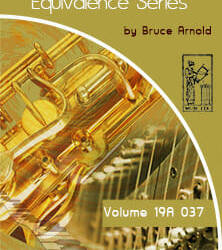
Harmonic and Melodic Equivalence V19A
Buy now for 1.00 USD
Promo code: buckbook
Harmonic and Melodic Equivalence V19A
Add digital copy to cart - $19.99
Status: In stock, Digital book is available for immediate access.
Melodic Rotations Learning to Improvise More Based on the Composition
"Harmonic and Melodic Equivalence" is a series of books that will help you to develop many different musical skills simultaneously. The source materials for these books are exercises that contain two 3 note groupings, also called "trichords," that are manipulated in various ways. These exercises use many different types of harmonic and melodic ideas that can be superimposed over common chord progressions, scales and other musical situations. The exercises found in these courses are also great for singing and rhythm studies. Finally, the "Harmonic and Melodic Equivalence" course concentrates on the use of the three note pitch class sets (trichords) by pairing each trichord with another trichord with the same prime form. For instance, in this volume C, Db, Eb and F#, G, A are both 013 pitch class sets because they both contain a 1/2 step and a minor 3rd within their interval structure. This is a great sequence because it uses six notes from a symmetrical diminished scale therefore you will find a ton of useful applications which are discussed in the course.
Harmonic and Melodic Equivalence Exercises
This course is divided up into two sets of exercises written in treble and bass clef. The 1st set of exercises gets gradually harder but also more musical. Depending upon your musical skills you can start anywhere you want but for beginners I would recommend starting from the 1st exercise of the five. The 2nd set of exercises are called "Atomic Scales." These exercises are a technical exercise that really helps you to learn these ideas but also sound great as a melody right off the bat. There are 6 different types of "Atomic Scales" exercises in this course. You don't have to play every exercise in every key. But doing this will greatly increase the likelihood of you using it in real music in the future. Below is a listing of the exercises found in this course:
Closed position studies.
1st inversion studies.
2nd inversion studies.
Random combinations of closed position along with 1st and 2nd inversion.
Random combinations of closed position along with 1st and 2nd inversion with rhythmic displacement.
Atomic Scales Exercise 1
Atomic Scales Exercise 2
Atomic Scales Exercise 3
Atomic Scales Exercise 4
Atomic Scales Exercise 5
Atomic Scales Exercise 6
Explanation of 1st Set of Exercises in Harmonic and Melodic Equivalence V19A Course
Below is an explanation for each set of the 6 different atomic scale exercises found in this course. Three octave sequences that move back and forth between the two 3 note groups are presented in six different configurations. These exercises are highly melodic and can be used verbatim as melodies when soloing. If we thought of the three notes as A,B,C then there would be six different ways to combine these notes. i.e. ABC, ACB, BAC, BCA, CAB and CBA. All exercises include MP3s as well as midi files so that you can hear and play these exercises at any tempo as well as versions in all 12 keys.
Three octave sequences that move back and forth between the two 3 note groups in the ABC sequence
Three octave sequences that move back and forth between the two 3 note groups in the ACB sequence
Three octave sequences that move back and forth between the two 3 note groups in the BAC sequence
Three octave sequences that move back and forth between the two 3 note groups in the BCA sequence
Three octave sequences that move back and forth between the two 3 note groups in the CAB sequence
Three octave sequences that move back and forth between the two 3 note groups in the CBA sequence
1st Set of Exercises in Harmonic and Melodic Equivalence V19A Course
Here are a few examples from the 1st set of exercises. A complete list of the different types of exercises can also be found below.
Closed Position Exercise
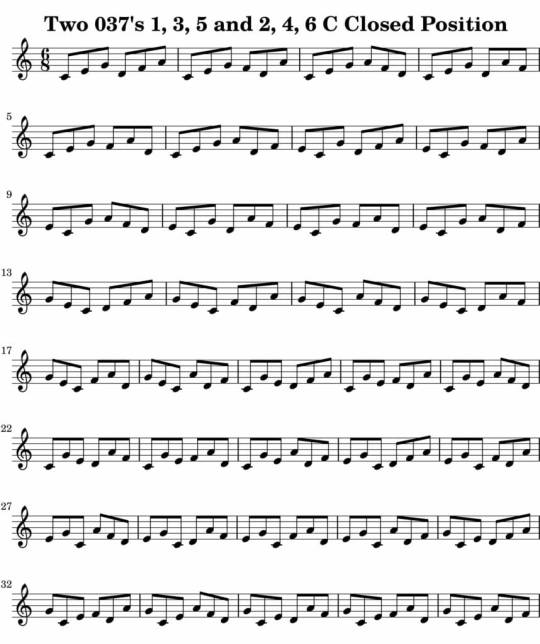
MP3 example
https://s3.amazonaws.com/media.muse-eek.com/mp3/HandMEV19A/01_037_Degree_1_3_5_2_4_6_Closed_Position_Key_C.mp3
1st Inversion Exercise
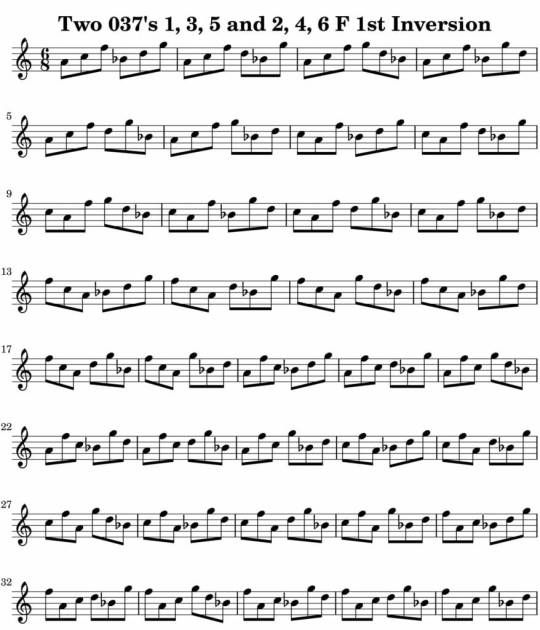
MP3 example
https://s3.amazonaws.com/media.muse-eek.com/mp3/HandMEV19A/02_037_Degree_1_3_5_2_4_6_1st_Inversion_Key_F.mp3
2nd Inversion Exercise

MP3 example
https://s3.amazonaws.com/media.muse-eek.com/mp3/HandMEV19A/03_037_Degree_1_3_5_2_4_6_2nd_Inversion_Key_Bb.mp3
Random combinations of closed position along with 1st and 2nd inversion.
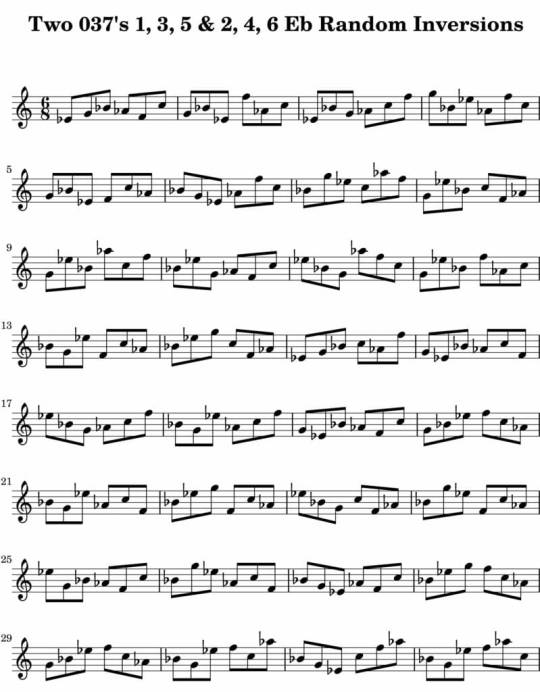
MP3 example
https://s3.amazonaws.com/media.muse-eek.com/mp3/HandMEV19A/04_037_Degree_1_3_5_2_4_6_Random_Inversions_Key_Eb.mp3
Random combinations of closed position along with 1st and 2nd inversion and rhythm permutation
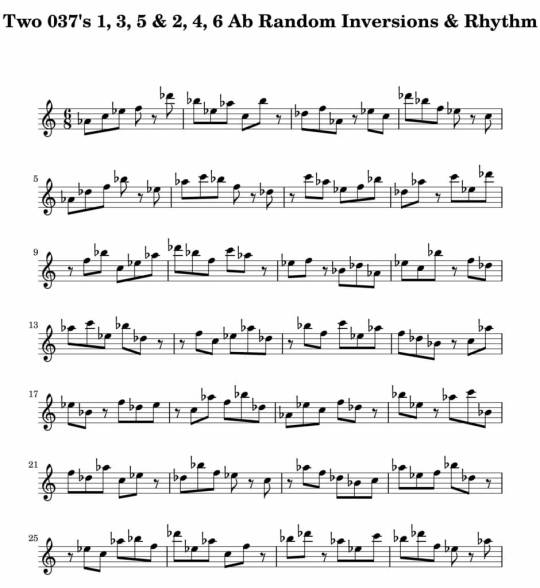
MP3 example
https://s3.amazonaws.com/media.muse-eek.com/mp3/HandMEV19A/05_037_Degree_1_3_5_2_4_6_Random_Inv_Rhy_Key_Ab.mp3
2nd Set of Exercises in Harmonic and Melodic Equivalence V19A Course
Here are a few examples from the 2nd set of exercises.
Atomic Scales 1st Rotation
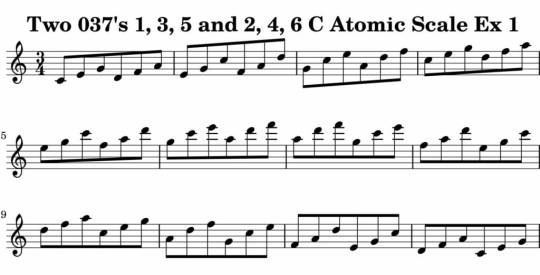
MP3 example
https://s3.amazonaws.com/media.muse-eek.com/mp3/HandMEV19A/01_037_Degree_1_3_5_2_4_6_Atomic_Scale_Ex_1_Key_C.mp3
Atomic Scales 2nd Rotation
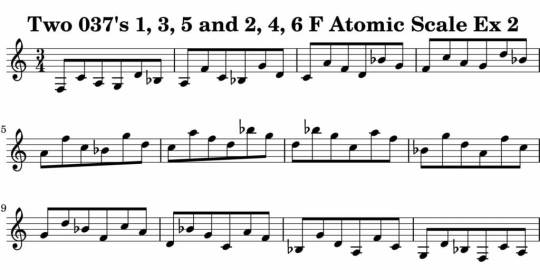
MP3 example
https://s3.amazonaws.com/media.muse-eek.com/mp3/HandMEV19A/02_037_Degree_1_3_5_2_4_6_Atomic_Scale_Ex_2_Key_F.mp3
Atomic Scales 3rd Rotation
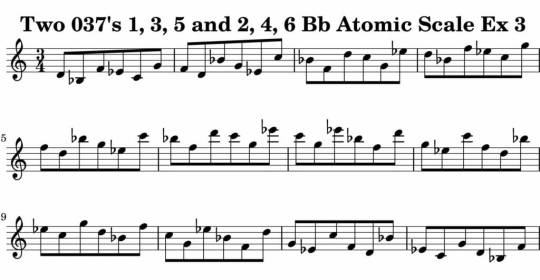
MP3 example
https://s3.amazonaws.com/media.muse-eek.com/mp3/HandMEV19A/03_037_Degree_1_3_5_2_4_6_Atomic_Scale_Ex_3_Key_Bb.mp3
Atomic Scales 4th Rotation
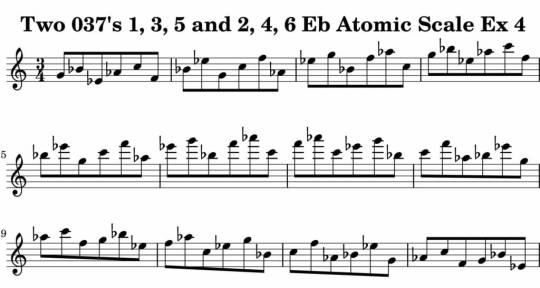
MP3 example
https://s3.amazonaws.com/media.muse-eek.com/mp3/HandMEV19A/04_037_Degree_1_3_5_2_4_6_Atomic_Scale_Ex_4_Key_Eb.mp3
Atomic Scales 5th Rotation
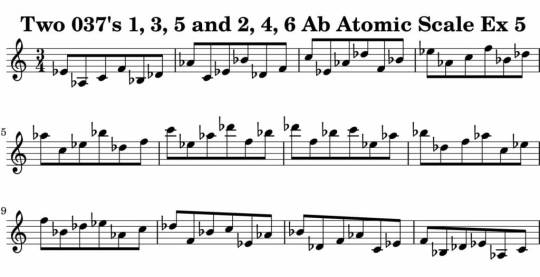
MP3 example
https://s3.amazonaws.com/media.muse-eek.com/mp3/HandMEV19A/05_037_Degree_1_3_5_2_4_6_Atomic_Scale_Ex_5_Key_Ab.mp3
Atomic Scales 6th Rotation

MP3 example
https://s3.amazonaws.com/media.muse-eek.com/mp3/HandMEV19A/06_037_Degree_1_3_5_2_4_6_Atomic_Scale_Ex_6_Key_Db.mp3
TOC in the Harmonic and Melodic Equivalence V19A Course:
How to Use This Course
Harmonic/Melodic Possibilities of Two 037's
Chord Possibilities of Two 037's
Rotations Starting on Every Eighth Note
Two 013's in Modal Playing
How to Think of the 013's Used in This Course
013 Daily Exercise-Atomic Scales
Thinking of the Trichords as Modes
Thinking of the Trichords as One Scale
C, E, G and D, F, A as One Scale in All Keys
Get Harmonic and Melodic Equivalence V19A Today!
Add digital copy to cart - $19.99
Status: In stock, Digital book is available for immediate access.
Additional Information for Harmonic and Melodic Equivalence V19A:
Digital Edition 978-1-59489-334-6
One 8 page PDF explaining exercises, 5 different types of exercises, 328 pages of exercises in PDF format in treble and bass clef
MP3's and Midi files for all exercises.
12 MP3s from Tuba MetroDrone®
What people are saying:
OK I'm a big fan of the band "Weather Report" and these two triad things are exactly what Joe Zawinal is doing during his improvisation...among other things of course. This is a great study Bruce! Thanks for pointing it out to me and showing me some places where it is used J. Ogland
I've been following your "Harmonic and Melodic Equivalence Series" and this volume is what sold me on the idea. There are some really cool melodies here that you can combine with pentatonics or blues. Thanks for making the course! R. Andersen
Hey just wanted to give you a shout out that I'm digging the atomic scales in these courses. That is an awesome technique that I can directly translate to my soloing. A. Newburg
Such a cool series Bruce. Thanks for creating these and making so many of these examples available on line K. Wilkes
Read the full article
0 notes